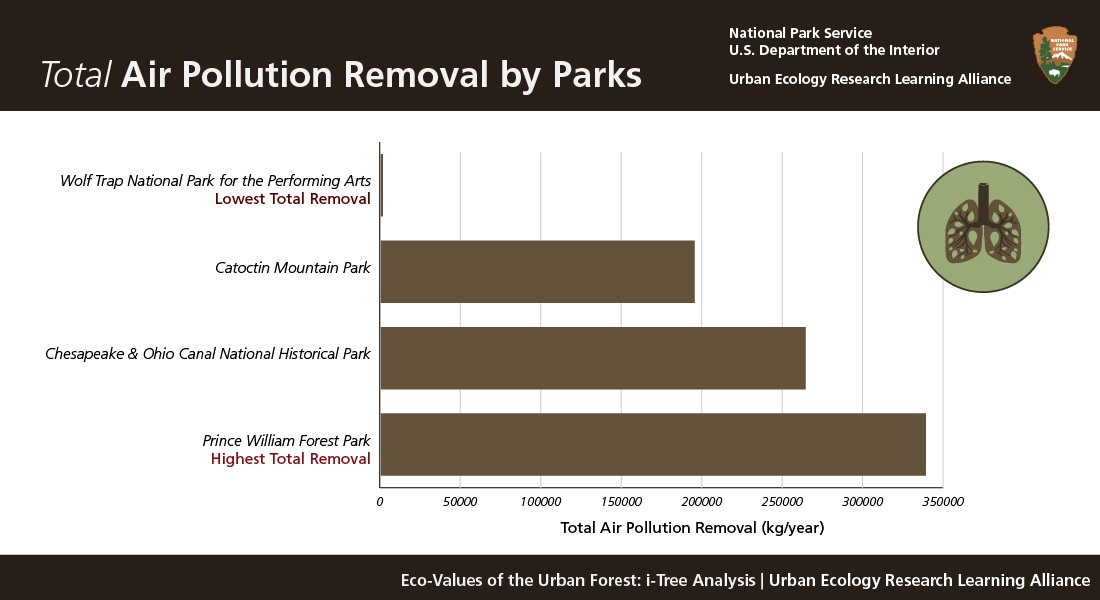Last updated: January 7, 2022
Article
Air Pollution Removal by Urban Forests

Trees can improve air quality through a number of means, including by (1) reducing air temperature thus altering pollution concentrations, (2) reducing energy consumption in buildings, which consequently reduces air pollutant emissions from the power sources, and most notably, (3) directly removing pollutants from the air. Urban forests can remove multiple tons of ozone, gaseous air pollution, and particulate matter each year either through direct uptake of gasses or temporarily intercepting airborne particles. The combined positive impacts of an urban forest lead to a net reduction in urban ozone formation, according to multiple studies from the USDA Forest Service.
Air Pollution Removal by NCA Urban Trees
The UERLA i-Tree analysis calculated the amount of pollution removed by urban forest tree-canopy in 11 National Capital Area parks. In total, these parks remove over 1.1 million metric tonnes of air pollution every year.

Pollution removal was calculated for ozone, sulfur dioxide (SO2), nitrogen dioxide (NO2), carbon monoxide (CO), and fine particulate matter less than 2.5 microns (PM2.5). These are classified as “criteria air pollutants” by the Environmental Protection Agency, meaning they are used as key indicators of air quality. Of the tonnes of the pollutants removed by NCA urban forests, a majority was ozone, according to the i-Tree analysis.
The rate of annual pollution removal by hectare varies by the different parks, partly due to their locations. Air pollution can be concentrated in urban areas because the burning of fossil fuels by automobiles in a concentrated area is a main source, and some NCA parks are considerably more urban than others.

NPS / Rachel Hendrix
How do trees remove air pollution?
Gaseous air pollution: Trees absorb gaseous molecules in the air. Tiny pores on tree leaf surfaces called stomata take in air that includes toxic pollutants. Once inside the leaf, the gases diffuse into intercellular spaces and may react with inner-leaf surfaces. This means pollutants like SO2, NO2, CO, and ozone are permanently converted when inside the leaf. However, studies have found that ground-level ozone significantly reduces tree growth, injures the foliage, and predisposes trees to insect and disease attack.
Particulate matter: Trees can remove particulate matter by “catching” them temporarily. Fine particulate matter is deposited on tree surfaces clinging to leaves and stems instead of floating about in the air. Most PM2.5 will only remain on surfaces. With rain or precipitation, the particulates can be dissolved in the stormwater runoff or transferred to the soil. Particulates can also be resuspended or re-enter the atmosphere, making the tree only a temporary retention site for many atmospheric particles.
The Value of Removing Air Pollution
Air pollutants can interfere with enjoyment of outdoor activities. A few of their impacts listed by the EPA include:
- PM2.5: Can cause serious health risks when inhaled and are the main cause of haze that obscures the view in our national parks.
- SO2 and NO2: Can harm the human respiratory system, react with other compounds to create more particulate matter pollution, and contribute to acid rain which damages structures and environments.
- Ground-level ozone: Can harm human health when breathed in and affect sensitive vegetation, particularly during the growth season.
- CO: Reduces the amount of oxygen that can be transported in the bloodstream to critical organs like the heart and brain. Can be a deadly threat at high concentrations indoors.
Monetary value of air pollution removal can be calculated based on the cost of adverse health effects, associated economic costs of air pollution, and the local change in pollution concentration and population. The monetary value for air pollution removal done by just three parks — Rock Creek, Monocacy, and Catoctin — is worth over $2.7 million a year.
Next page: Carbon Storage
Previous: Overview of the Urban Forests
NPS Graphic
References
Ferguson, K. (2017). UERLA Resource Brief: Ecobenefits of National Capital Region Park Trees. Retrieved from https://irma.nps.gov/DataStore/Reference/Profile/2290091.
Environmental Protection Agency. (n.d.). Criteria Air Pollutants. Retrieved from https://www.epa.gov/criteria-air-pollutants
Garner, J. (2018). UERLA Resource Brief: Quantifying Ecological Benefits of Trees in the National Capital Region. Retrieved from https://irma.nps.gov/DataStore/Reference/Profile/2290092.
National Park Service. (2018). National Parks and the Clean Air Act. Retrieved from https://www.nps.gov/subjects/air/cleanairact.htm
National Park Service. (2018). Ozone Effects on Tree Growth. Retrieved from https://www.nps.gov/subjects/air/nature-trees.htm
Nowak, D. J. (2002). The Effects Of Urban Trees On Air Quality. Retrieved from https://www.nrs.fs.fed.us/units/urban/local-resources/downloads/Tree_Air_Qual.pdf
Urban Ecology Research Learning Alliance. (2018). i-Tree Ecosystem Analysis: Urban Forest Effects and Values. Retrieved from https://irma.nps.gov/DataStore/Reference/Profile/2290090.
U.S. Forest Service, National Park Service, and U.S. Fish and Wildlife Service. (2010). Federal land managers’ air quality related values work group (FLAG): phase I report—revised (2010). Natural Resource Report NPS/ NRPC/NRR—2010/232. National Park Service, Denver, Colorado. Retrieved from https://irma.nps.gov/DataStore/DownloadFile/420352
Tags
- antietam national battlefield
- chesapeake & ohio canal national historical park
- george washington memorial parkway
- harpers ferry national historical park
- manassas national battlefield park
- national capital parks-east
- prince william forest park
- wolf trap national park for the performing arts
- uerla
- rlc
- trees
- urban forest
- forest
- ecosystem services
- park science
- nca
- ncr
- air pollution
- air pollution effects
- air quality
